Professional Development: Ethical Practices Report in Australia
VerifiedAdded on 2023/06/10
|11
|2288
|243
Report
AI Summary
This report details professional development activities focusing on ethical practices within the interpreting profession in Australia. It identifies and compares key interpreting associations like AUSIT, Professionals Australia, and ASLIA, highlighting their similarities and differences. The report then describes coaching and understudy training as crucial professional development activities, emphasizing their alignment with ethical codes such as confidentiality, respect, and equity. A personal account of attending a 10-day conference in Sydney is provided, where the author gained valuable insights into coaching, feedback counseling, and understudy training. The report analyzes the lessons learned, including enhanced leadership skills, improved performance, and the importance of integrity. Networking experiences with managers and colleagues are also discussed, concluding with a reflection on the conference's success and the establishment of new professional contacts. Desklib provides this document along with a wealth of resources to support students in their academic journey.
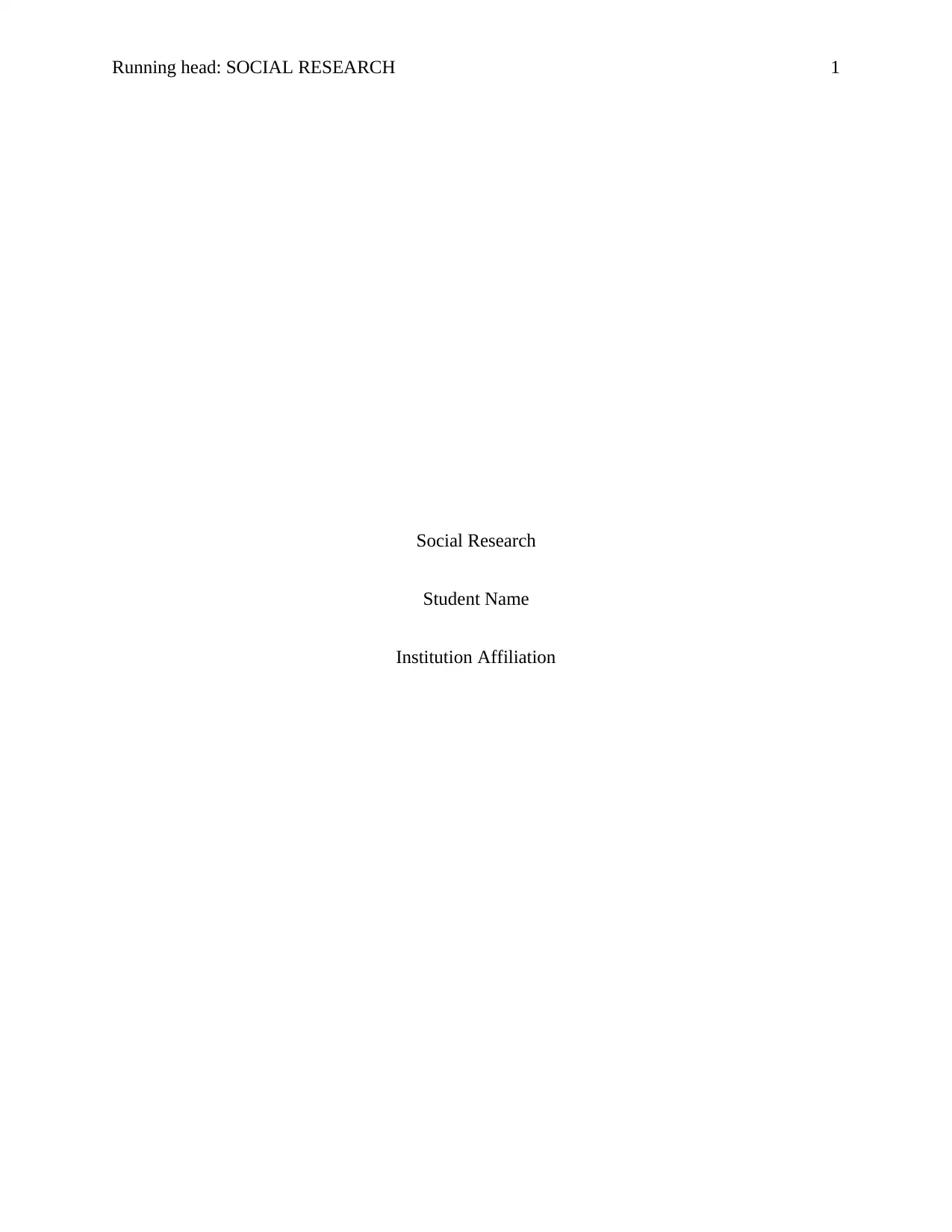
Running head: SOCIAL RESEARCH 1
Social Research
Student Name
Institution Affiliation
Social Research
Student Name
Institution Affiliation
Paraphrase This Document
Need a fresh take? Get an instant paraphrase of this document with our AI Paraphraser
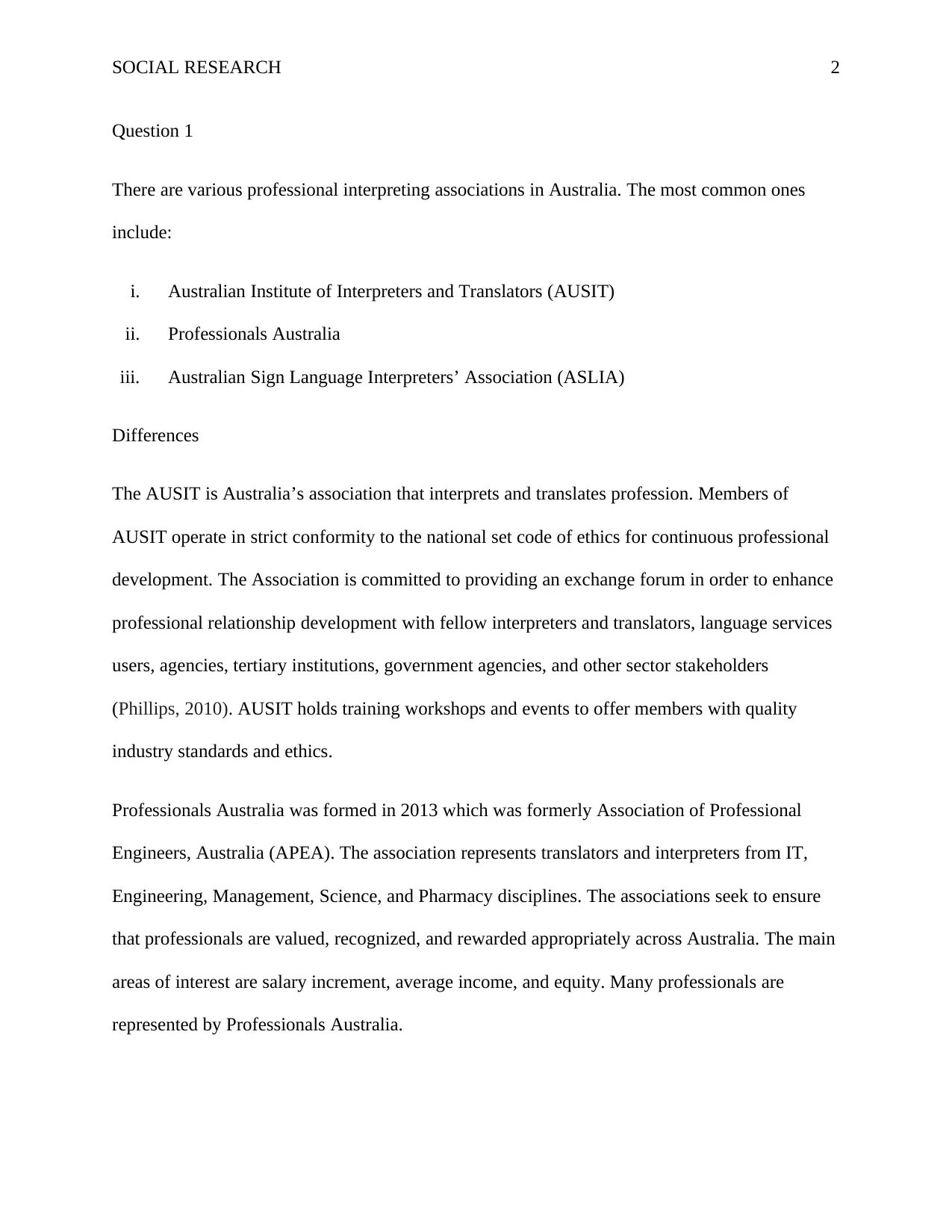
SOCIAL RESEARCH 2
Question 1
There are various professional interpreting associations in Australia. The most common ones
include:
i. Australian Institute of Interpreters and Translators (AUSIT)
ii. Professionals Australia
iii. Australian Sign Language Interpreters’ Association (ASLIA)
Differences
The AUSIT is Australia’s association that interprets and translates profession. Members of
AUSIT operate in strict conformity to the national set code of ethics for continuous professional
development. The Association is committed to providing an exchange forum in order to enhance
professional relationship development with fellow interpreters and translators, language services
users, agencies, tertiary institutions, government agencies, and other sector stakeholders
(Phillips, 2010). AUSIT holds training workshops and events to offer members with quality
industry standards and ethics.
Professionals Australia was formed in 2013 which was formerly Association of Professional
Engineers, Australia (APEA). The association represents translators and interpreters from IT,
Engineering, Management, Science, and Pharmacy disciplines. The associations seek to ensure
that professionals are valued, recognized, and rewarded appropriately across Australia. The main
areas of interest are salary increment, average income, and equity. Many professionals are
represented by Professionals Australia.
Question 1
There are various professional interpreting associations in Australia. The most common ones
include:
i. Australian Institute of Interpreters and Translators (AUSIT)
ii. Professionals Australia
iii. Australian Sign Language Interpreters’ Association (ASLIA)
Differences
The AUSIT is Australia’s association that interprets and translates profession. Members of
AUSIT operate in strict conformity to the national set code of ethics for continuous professional
development. The Association is committed to providing an exchange forum in order to enhance
professional relationship development with fellow interpreters and translators, language services
users, agencies, tertiary institutions, government agencies, and other sector stakeholders
(Phillips, 2010). AUSIT holds training workshops and events to offer members with quality
industry standards and ethics.
Professionals Australia was formed in 2013 which was formerly Association of Professional
Engineers, Australia (APEA). The association represents translators and interpreters from IT,
Engineering, Management, Science, and Pharmacy disciplines. The associations seek to ensure
that professionals are valued, recognized, and rewarded appropriately across Australia. The main
areas of interest are salary increment, average income, and equity. Many professionals are
represented by Professionals Australia.
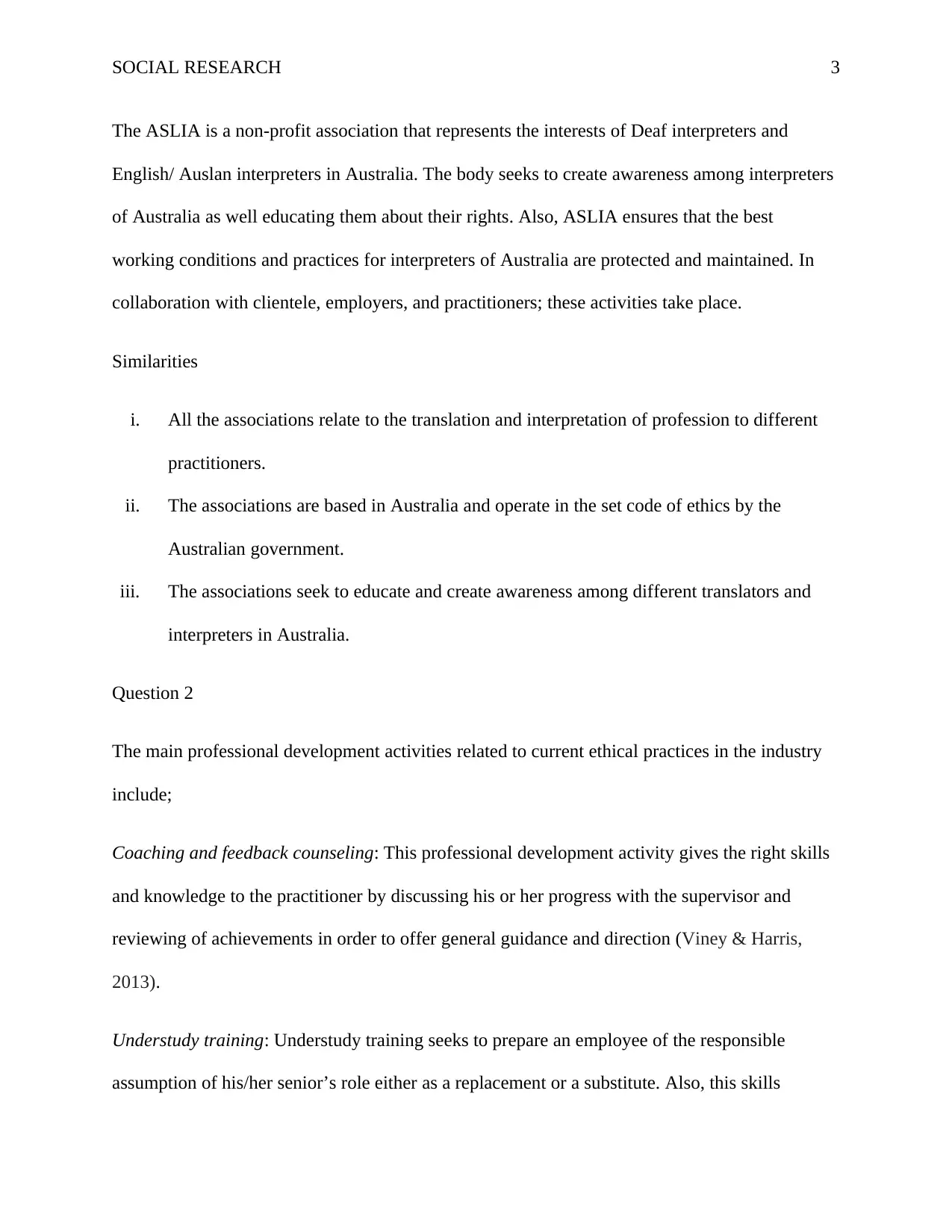
SOCIAL RESEARCH 3
The ASLIA is a non-profit association that represents the interests of Deaf interpreters and
English/ Auslan interpreters in Australia. The body seeks to create awareness among interpreters
of Australia as well educating them about their rights. Also, ASLIA ensures that the best
working conditions and practices for interpreters of Australia are protected and maintained. In
collaboration with clientele, employers, and practitioners; these activities take place.
Similarities
i. All the associations relate to the translation and interpretation of profession to different
practitioners.
ii. The associations are based in Australia and operate in the set code of ethics by the
Australian government.
iii. The associations seek to educate and create awareness among different translators and
interpreters in Australia.
Question 2
The main professional development activities related to current ethical practices in the industry
include;
Coaching and feedback counseling: This professional development activity gives the right skills
and knowledge to the practitioner by discussing his or her progress with the supervisor and
reviewing of achievements in order to offer general guidance and direction (Viney & Harris,
2013).
Understudy training: Understudy training seeks to prepare an employee of the responsible
assumption of his/her senior’s role either as a replacement or a substitute. Also, this skills
The ASLIA is a non-profit association that represents the interests of Deaf interpreters and
English/ Auslan interpreters in Australia. The body seeks to create awareness among interpreters
of Australia as well educating them about their rights. Also, ASLIA ensures that the best
working conditions and practices for interpreters of Australia are protected and maintained. In
collaboration with clientele, employers, and practitioners; these activities take place.
Similarities
i. All the associations relate to the translation and interpretation of profession to different
practitioners.
ii. The associations are based in Australia and operate in the set code of ethics by the
Australian government.
iii. The associations seek to educate and create awareness among different translators and
interpreters in Australia.
Question 2
The main professional development activities related to current ethical practices in the industry
include;
Coaching and feedback counseling: This professional development activity gives the right skills
and knowledge to the practitioner by discussing his or her progress with the supervisor and
reviewing of achievements in order to offer general guidance and direction (Viney & Harris,
2013).
Understudy training: Understudy training seeks to prepare an employee of the responsible
assumption of his/her senior’s role either as a replacement or a substitute. Also, this skills
You're viewing a preview
Unlock full access by subscribing today!
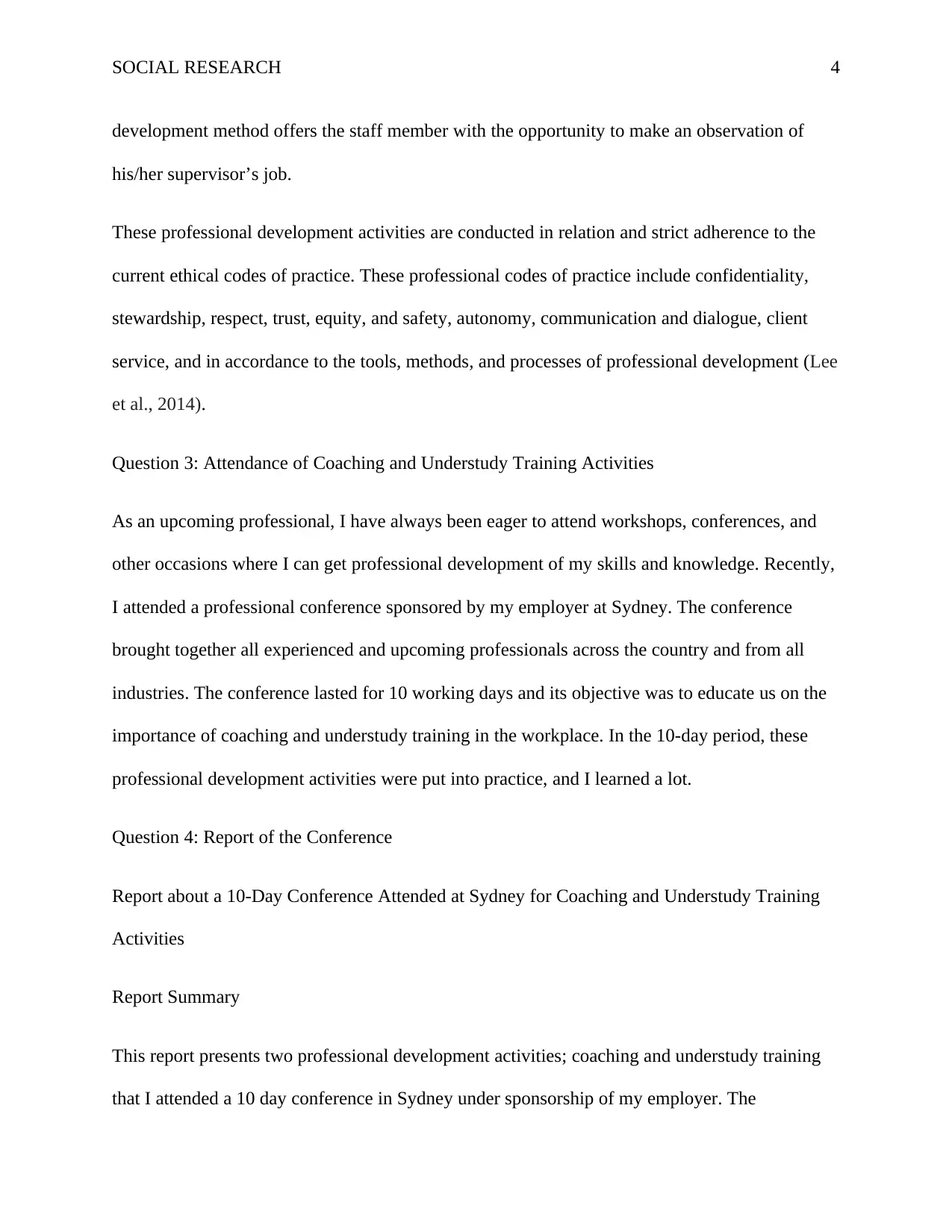
SOCIAL RESEARCH 4
development method offers the staff member with the opportunity to make an observation of
his/her supervisor’s job.
These professional development activities are conducted in relation and strict adherence to the
current ethical codes of practice. These professional codes of practice include confidentiality,
stewardship, respect, trust, equity, and safety, autonomy, communication and dialogue, client
service, and in accordance to the tools, methods, and processes of professional development (Lee
et al., 2014).
Question 3: Attendance of Coaching and Understudy Training Activities
As an upcoming professional, I have always been eager to attend workshops, conferences, and
other occasions where I can get professional development of my skills and knowledge. Recently,
I attended a professional conference sponsored by my employer at Sydney. The conference
brought together all experienced and upcoming professionals across the country and from all
industries. The conference lasted for 10 working days and its objective was to educate us on the
importance of coaching and understudy training in the workplace. In the 10-day period, these
professional development activities were put into practice, and I learned a lot.
Question 4: Report of the Conference
Report about a 10-Day Conference Attended at Sydney for Coaching and Understudy Training
Activities
Report Summary
This report presents two professional development activities; coaching and understudy training
that I attended a 10 day conference in Sydney under sponsorship of my employer. The
development method offers the staff member with the opportunity to make an observation of
his/her supervisor’s job.
These professional development activities are conducted in relation and strict adherence to the
current ethical codes of practice. These professional codes of practice include confidentiality,
stewardship, respect, trust, equity, and safety, autonomy, communication and dialogue, client
service, and in accordance to the tools, methods, and processes of professional development (Lee
et al., 2014).
Question 3: Attendance of Coaching and Understudy Training Activities
As an upcoming professional, I have always been eager to attend workshops, conferences, and
other occasions where I can get professional development of my skills and knowledge. Recently,
I attended a professional conference sponsored by my employer at Sydney. The conference
brought together all experienced and upcoming professionals across the country and from all
industries. The conference lasted for 10 working days and its objective was to educate us on the
importance of coaching and understudy training in the workplace. In the 10-day period, these
professional development activities were put into practice, and I learned a lot.
Question 4: Report of the Conference
Report about a 10-Day Conference Attended at Sydney for Coaching and Understudy Training
Activities
Report Summary
This report presents two professional development activities; coaching and understudy training
that I attended a 10 day conference in Sydney under sponsorship of my employer. The
Paraphrase This Document
Need a fresh take? Get an instant paraphrase of this document with our AI Paraphraser
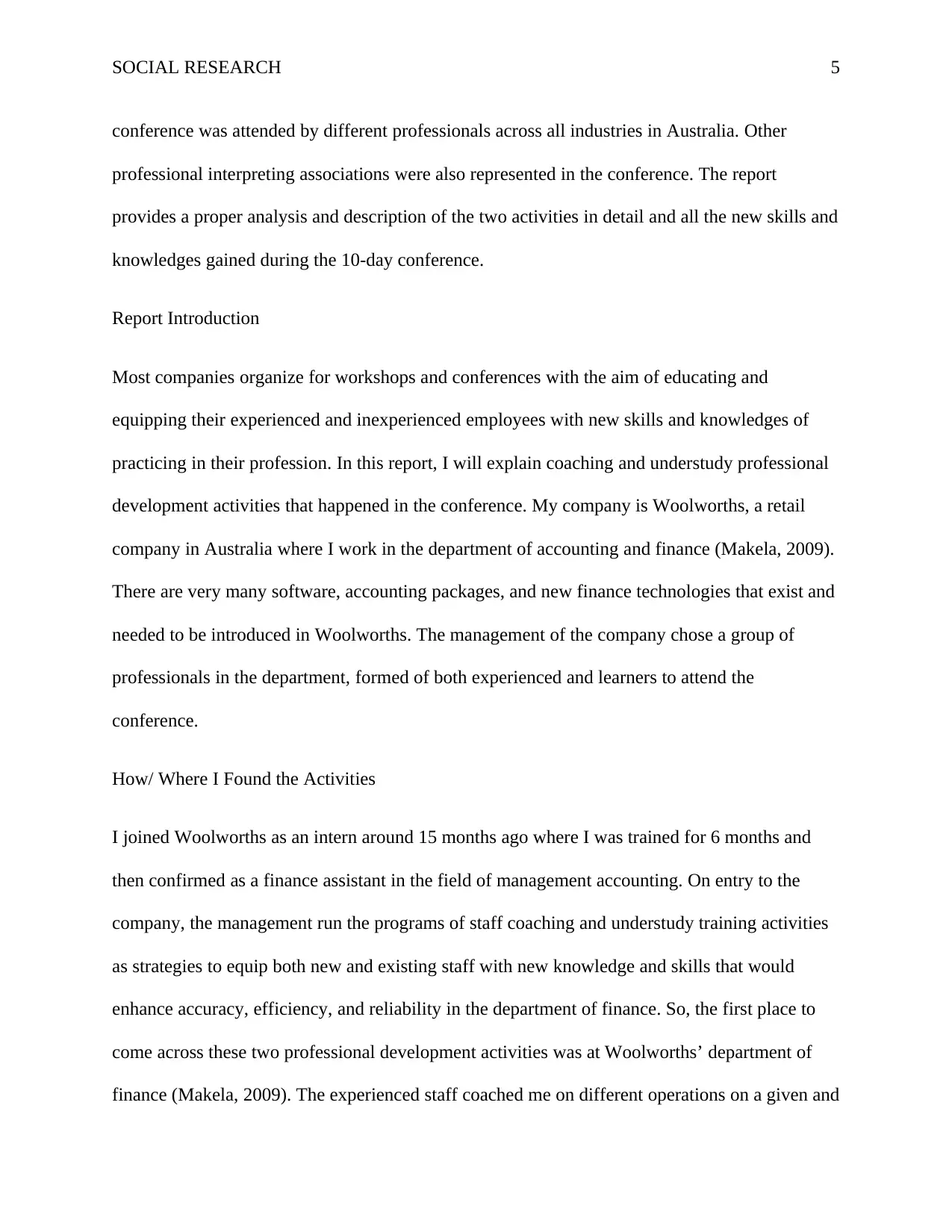
SOCIAL RESEARCH 5
conference was attended by different professionals across all industries in Australia. Other
professional interpreting associations were also represented in the conference. The report
provides a proper analysis and description of the two activities in detail and all the new skills and
knowledges gained during the 10-day conference.
Report Introduction
Most companies organize for workshops and conferences with the aim of educating and
equipping their experienced and inexperienced employees with new skills and knowledges of
practicing in their profession. In this report, I will explain coaching and understudy professional
development activities that happened in the conference. My company is Woolworths, a retail
company in Australia where I work in the department of accounting and finance (Makela, 2009).
There are very many software, accounting packages, and new finance technologies that exist and
needed to be introduced in Woolworths. The management of the company chose a group of
professionals in the department, formed of both experienced and learners to attend the
conference.
How/ Where I Found the Activities
I joined Woolworths as an intern around 15 months ago where I was trained for 6 months and
then confirmed as a finance assistant in the field of management accounting. On entry to the
company, the management run the programs of staff coaching and understudy training activities
as strategies to equip both new and existing staff with new knowledge and skills that would
enhance accuracy, efficiency, and reliability in the department of finance. So, the first place to
come across these two professional development activities was at Woolworths’ department of
finance (Makela, 2009). The experienced staff coached me on different operations on a given and
conference was attended by different professionals across all industries in Australia. Other
professional interpreting associations were also represented in the conference. The report
provides a proper analysis and description of the two activities in detail and all the new skills and
knowledges gained during the 10-day conference.
Report Introduction
Most companies organize for workshops and conferences with the aim of educating and
equipping their experienced and inexperienced employees with new skills and knowledges of
practicing in their profession. In this report, I will explain coaching and understudy professional
development activities that happened in the conference. My company is Woolworths, a retail
company in Australia where I work in the department of accounting and finance (Makela, 2009).
There are very many software, accounting packages, and new finance technologies that exist and
needed to be introduced in Woolworths. The management of the company chose a group of
professionals in the department, formed of both experienced and learners to attend the
conference.
How/ Where I Found the Activities
I joined Woolworths as an intern around 15 months ago where I was trained for 6 months and
then confirmed as a finance assistant in the field of management accounting. On entry to the
company, the management run the programs of staff coaching and understudy training activities
as strategies to equip both new and existing staff with new knowledge and skills that would
enhance accuracy, efficiency, and reliability in the department of finance. So, the first place to
come across these two professional development activities was at Woolworths’ department of
finance (Makela, 2009). The experienced staff coached me on different operations on a given and
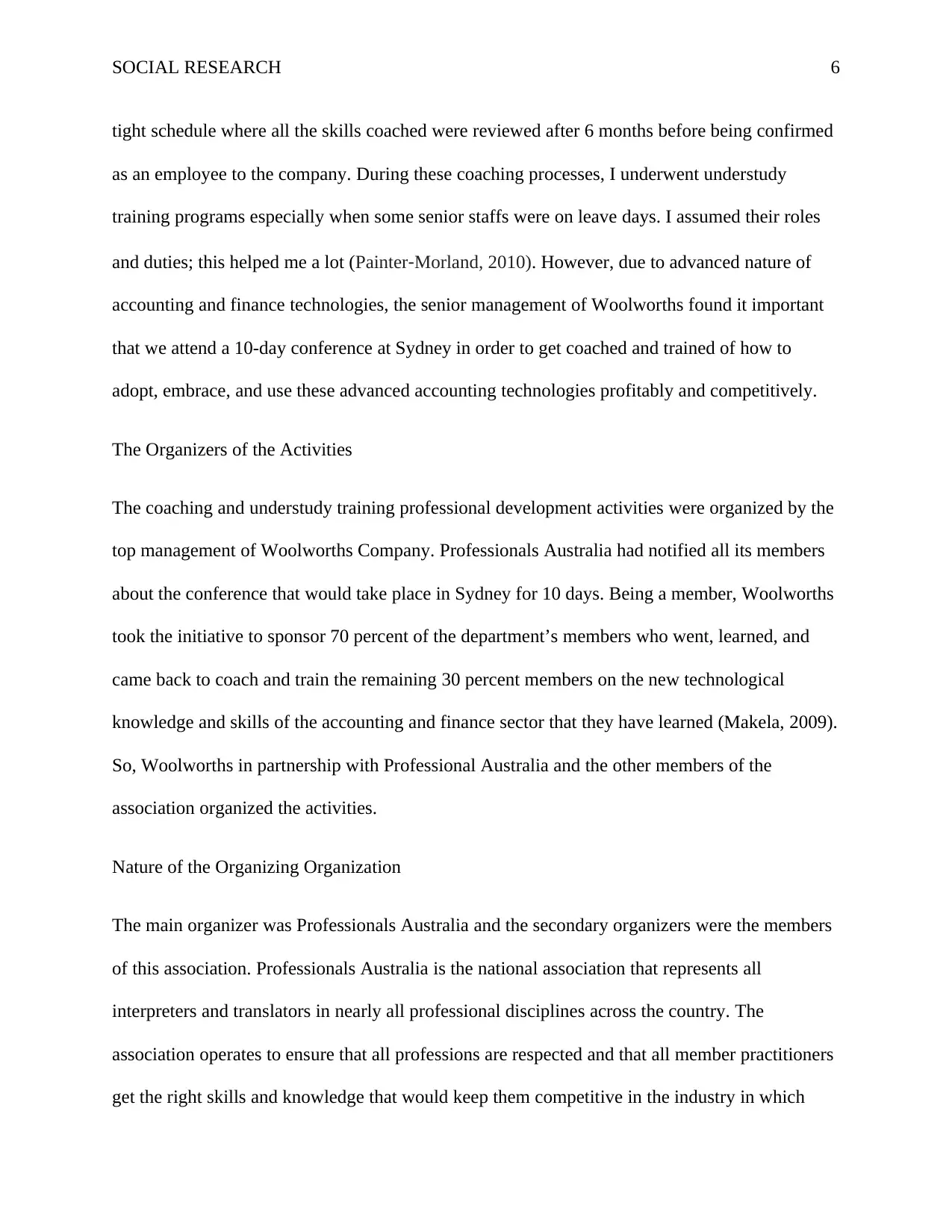
SOCIAL RESEARCH 6
tight schedule where all the skills coached were reviewed after 6 months before being confirmed
as an employee to the company. During these coaching processes, I underwent understudy
training programs especially when some senior staffs were on leave days. I assumed their roles
and duties; this helped me a lot (Painter‐Morland, 2010). However, due to advanced nature of
accounting and finance technologies, the senior management of Woolworths found it important
that we attend a 10-day conference at Sydney in order to get coached and trained of how to
adopt, embrace, and use these advanced accounting technologies profitably and competitively.
The Organizers of the Activities
The coaching and understudy training professional development activities were organized by the
top management of Woolworths Company. Professionals Australia had notified all its members
about the conference that would take place in Sydney for 10 days. Being a member, Woolworths
took the initiative to sponsor 70 percent of the department’s members who went, learned, and
came back to coach and train the remaining 30 percent members on the new technological
knowledge and skills of the accounting and finance sector that they have learned (Makela, 2009).
So, Woolworths in partnership with Professional Australia and the other members of the
association organized the activities.
Nature of the Organizing Organization
The main organizer was Professionals Australia and the secondary organizers were the members
of this association. Professionals Australia is the national association that represents all
interpreters and translators in nearly all professional disciplines across the country. The
association operates to ensure that all professions are respected and that all member practitioners
get the right skills and knowledge that would keep them competitive in the industry in which
tight schedule where all the skills coached were reviewed after 6 months before being confirmed
as an employee to the company. During these coaching processes, I underwent understudy
training programs especially when some senior staffs were on leave days. I assumed their roles
and duties; this helped me a lot (Painter‐Morland, 2010). However, due to advanced nature of
accounting and finance technologies, the senior management of Woolworths found it important
that we attend a 10-day conference at Sydney in order to get coached and trained of how to
adopt, embrace, and use these advanced accounting technologies profitably and competitively.
The Organizers of the Activities
The coaching and understudy training professional development activities were organized by the
top management of Woolworths Company. Professionals Australia had notified all its members
about the conference that would take place in Sydney for 10 days. Being a member, Woolworths
took the initiative to sponsor 70 percent of the department’s members who went, learned, and
came back to coach and train the remaining 30 percent members on the new technological
knowledge and skills of the accounting and finance sector that they have learned (Makela, 2009).
So, Woolworths in partnership with Professional Australia and the other members of the
association organized the activities.
Nature of the Organizing Organization
The main organizer was Professionals Australia and the secondary organizers were the members
of this association. Professionals Australia is the national association that represents all
interpreters and translators in nearly all professional disciplines across the country. The
association operates to ensure that all professions are respected and that all member practitioners
get the right skills and knowledge that would keep them competitive in the industry in which
You're viewing a preview
Unlock full access by subscribing today!
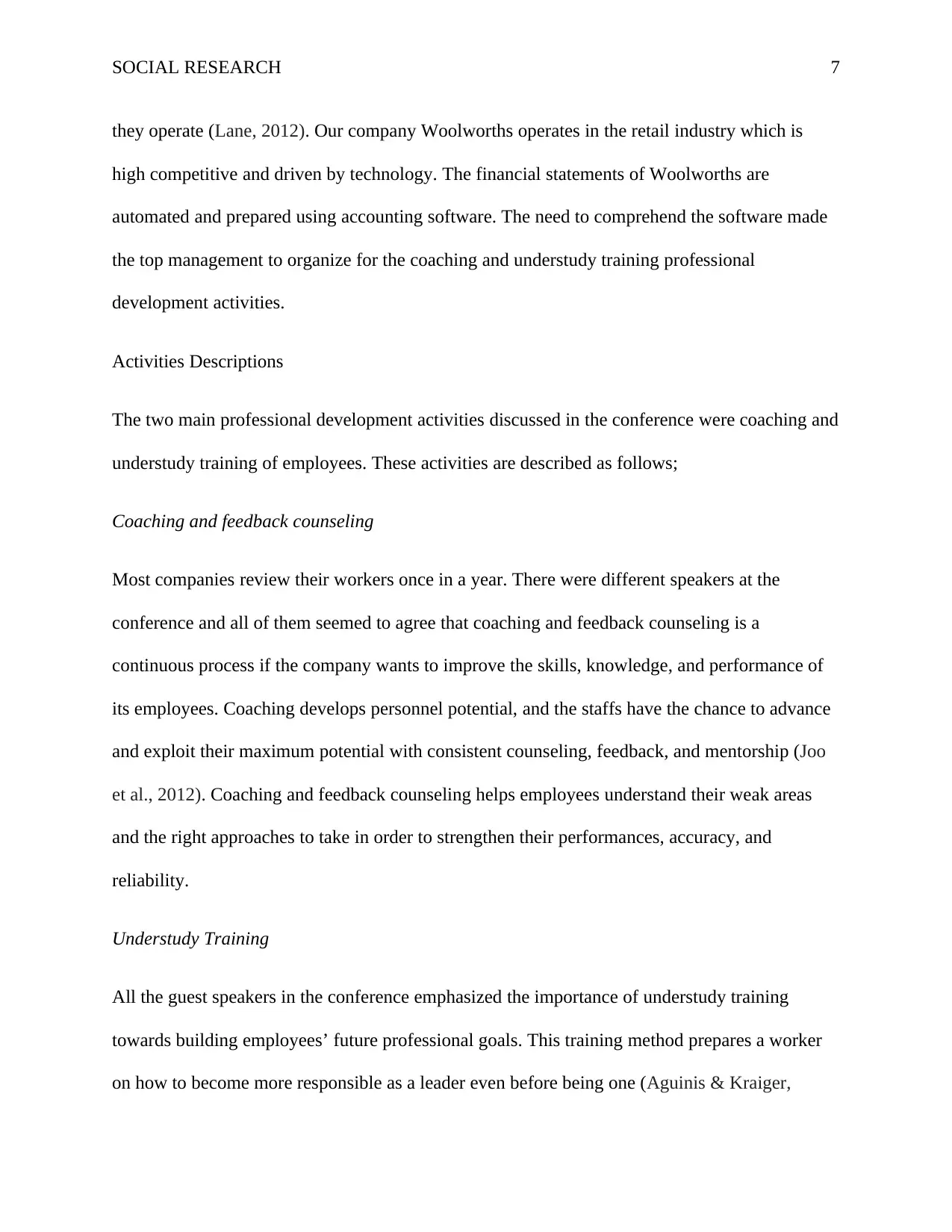
SOCIAL RESEARCH 7
they operate (Lane, 2012). Our company Woolworths operates in the retail industry which is
high competitive and driven by technology. The financial statements of Woolworths are
automated and prepared using accounting software. The need to comprehend the software made
the top management to organize for the coaching and understudy training professional
development activities.
Activities Descriptions
The two main professional development activities discussed in the conference were coaching and
understudy training of employees. These activities are described as follows;
Coaching and feedback counseling
Most companies review their workers once in a year. There were different speakers at the
conference and all of them seemed to agree that coaching and feedback counseling is a
continuous process if the company wants to improve the skills, knowledge, and performance of
its employees. Coaching develops personnel potential, and the staffs have the chance to advance
and exploit their maximum potential with consistent counseling, feedback, and mentorship (Joo
et al., 2012). Coaching and feedback counseling helps employees understand their weak areas
and the right approaches to take in order to strengthen their performances, accuracy, and
reliability.
Understudy Training
All the guest speakers in the conference emphasized the importance of understudy training
towards building employees’ future professional goals. This training method prepares a worker
on how to become more responsible as a leader even before being one (Aguinis & Kraiger,
they operate (Lane, 2012). Our company Woolworths operates in the retail industry which is
high competitive and driven by technology. The financial statements of Woolworths are
automated and prepared using accounting software. The need to comprehend the software made
the top management to organize for the coaching and understudy training professional
development activities.
Activities Descriptions
The two main professional development activities discussed in the conference were coaching and
understudy training of employees. These activities are described as follows;
Coaching and feedback counseling
Most companies review their workers once in a year. There were different speakers at the
conference and all of them seemed to agree that coaching and feedback counseling is a
continuous process if the company wants to improve the skills, knowledge, and performance of
its employees. Coaching develops personnel potential, and the staffs have the chance to advance
and exploit their maximum potential with consistent counseling, feedback, and mentorship (Joo
et al., 2012). Coaching and feedback counseling helps employees understand their weak areas
and the right approaches to take in order to strengthen their performances, accuracy, and
reliability.
Understudy Training
All the guest speakers in the conference emphasized the importance of understudy training
towards building employees’ future professional goals. This training method prepares a worker
on how to become more responsible as a leader even before being one (Aguinis & Kraiger,
Paraphrase This Document
Need a fresh take? Get an instant paraphrase of this document with our AI Paraphraser
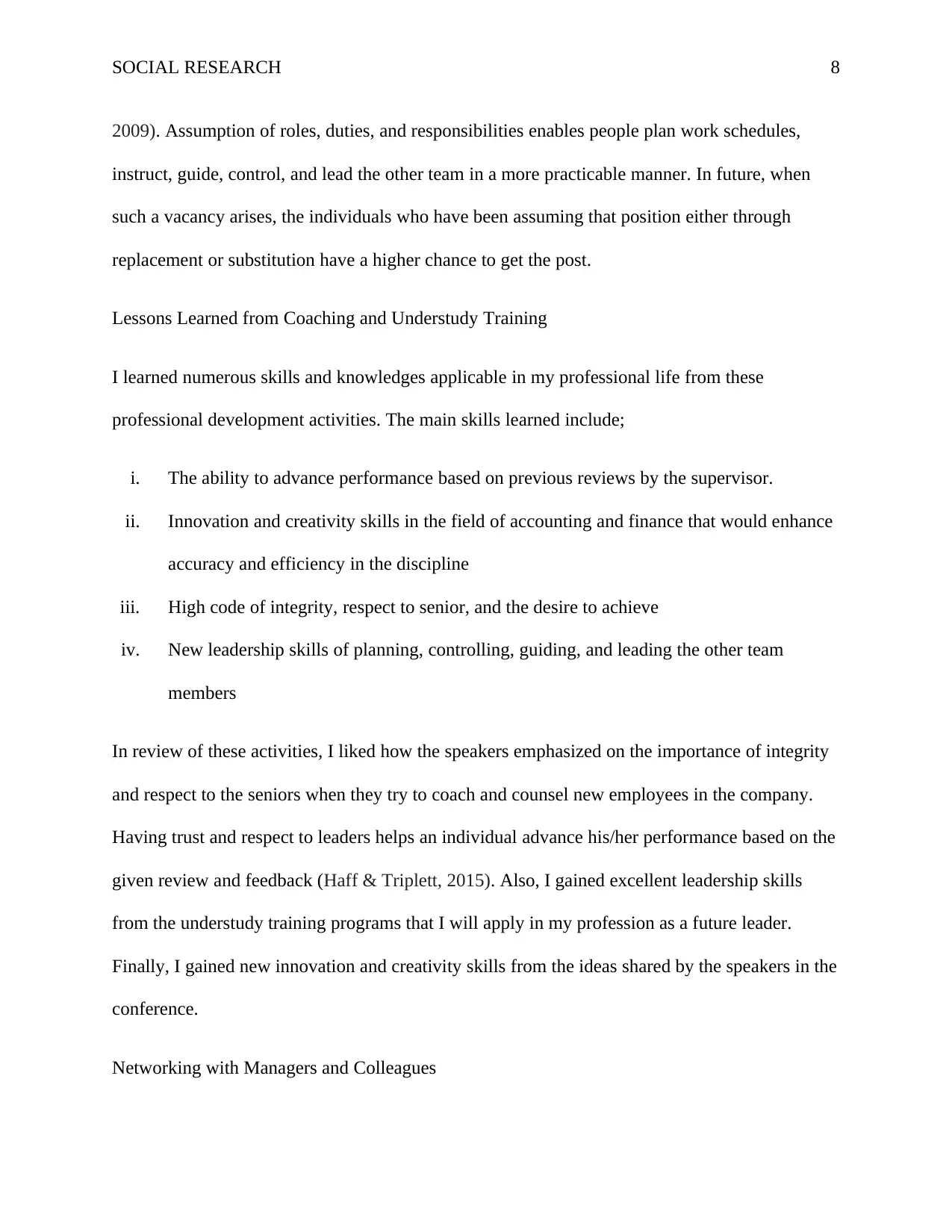
SOCIAL RESEARCH 8
2009). Assumption of roles, duties, and responsibilities enables people plan work schedules,
instruct, guide, control, and lead the other team in a more practicable manner. In future, when
such a vacancy arises, the individuals who have been assuming that position either through
replacement or substitution have a higher chance to get the post.
Lessons Learned from Coaching and Understudy Training
I learned numerous skills and knowledges applicable in my professional life from these
professional development activities. The main skills learned include;
i. The ability to advance performance based on previous reviews by the supervisor.
ii. Innovation and creativity skills in the field of accounting and finance that would enhance
accuracy and efficiency in the discipline
iii. High code of integrity, respect to senior, and the desire to achieve
iv. New leadership skills of planning, controlling, guiding, and leading the other team
members
In review of these activities, I liked how the speakers emphasized on the importance of integrity
and respect to the seniors when they try to coach and counsel new employees in the company.
Having trust and respect to leaders helps an individual advance his/her performance based on the
given review and feedback (Haff & Triplett, 2015). Also, I gained excellent leadership skills
from the understudy training programs that I will apply in my profession as a future leader.
Finally, I gained new innovation and creativity skills from the ideas shared by the speakers in the
conference.
Networking with Managers and Colleagues
2009). Assumption of roles, duties, and responsibilities enables people plan work schedules,
instruct, guide, control, and lead the other team in a more practicable manner. In future, when
such a vacancy arises, the individuals who have been assuming that position either through
replacement or substitution have a higher chance to get the post.
Lessons Learned from Coaching and Understudy Training
I learned numerous skills and knowledges applicable in my professional life from these
professional development activities. The main skills learned include;
i. The ability to advance performance based on previous reviews by the supervisor.
ii. Innovation and creativity skills in the field of accounting and finance that would enhance
accuracy and efficiency in the discipline
iii. High code of integrity, respect to senior, and the desire to achieve
iv. New leadership skills of planning, controlling, guiding, and leading the other team
members
In review of these activities, I liked how the speakers emphasized on the importance of integrity
and respect to the seniors when they try to coach and counsel new employees in the company.
Having trust and respect to leaders helps an individual advance his/her performance based on the
given review and feedback (Haff & Triplett, 2015). Also, I gained excellent leadership skills
from the understudy training programs that I will apply in my profession as a future leader.
Finally, I gained new innovation and creativity skills from the ideas shared by the speakers in the
conference.
Networking with Managers and Colleagues
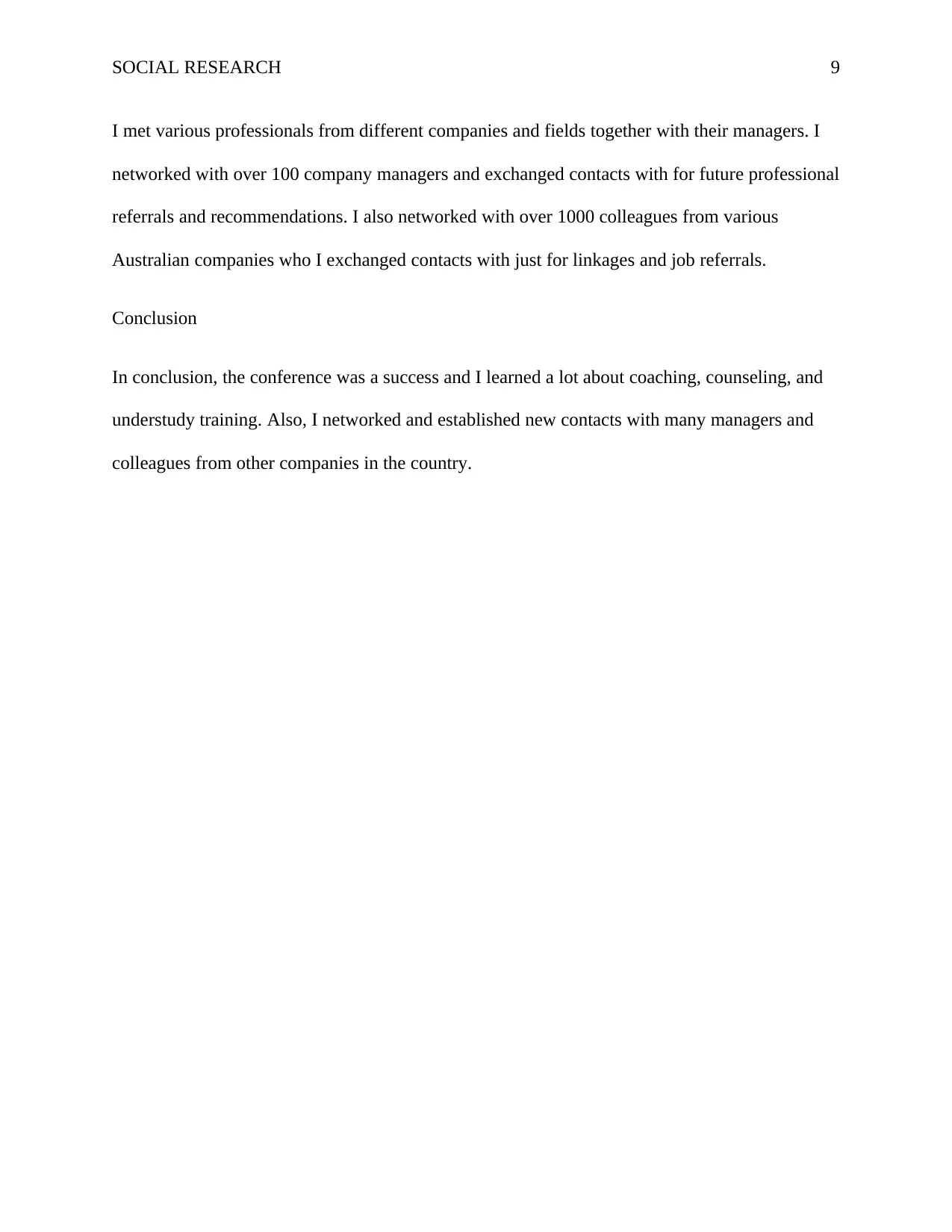
SOCIAL RESEARCH 9
I met various professionals from different companies and fields together with their managers. I
networked with over 100 company managers and exchanged contacts with for future professional
referrals and recommendations. I also networked with over 1000 colleagues from various
Australian companies who I exchanged contacts with just for linkages and job referrals.
Conclusion
In conclusion, the conference was a success and I learned a lot about coaching, counseling, and
understudy training. Also, I networked and established new contacts with many managers and
colleagues from other companies in the country.
I met various professionals from different companies and fields together with their managers. I
networked with over 100 company managers and exchanged contacts with for future professional
referrals and recommendations. I also networked with over 1000 colleagues from various
Australian companies who I exchanged contacts with just for linkages and job referrals.
Conclusion
In conclusion, the conference was a success and I learned a lot about coaching, counseling, and
understudy training. Also, I networked and established new contacts with many managers and
colleagues from other companies in the country.
You're viewing a preview
Unlock full access by subscribing today!
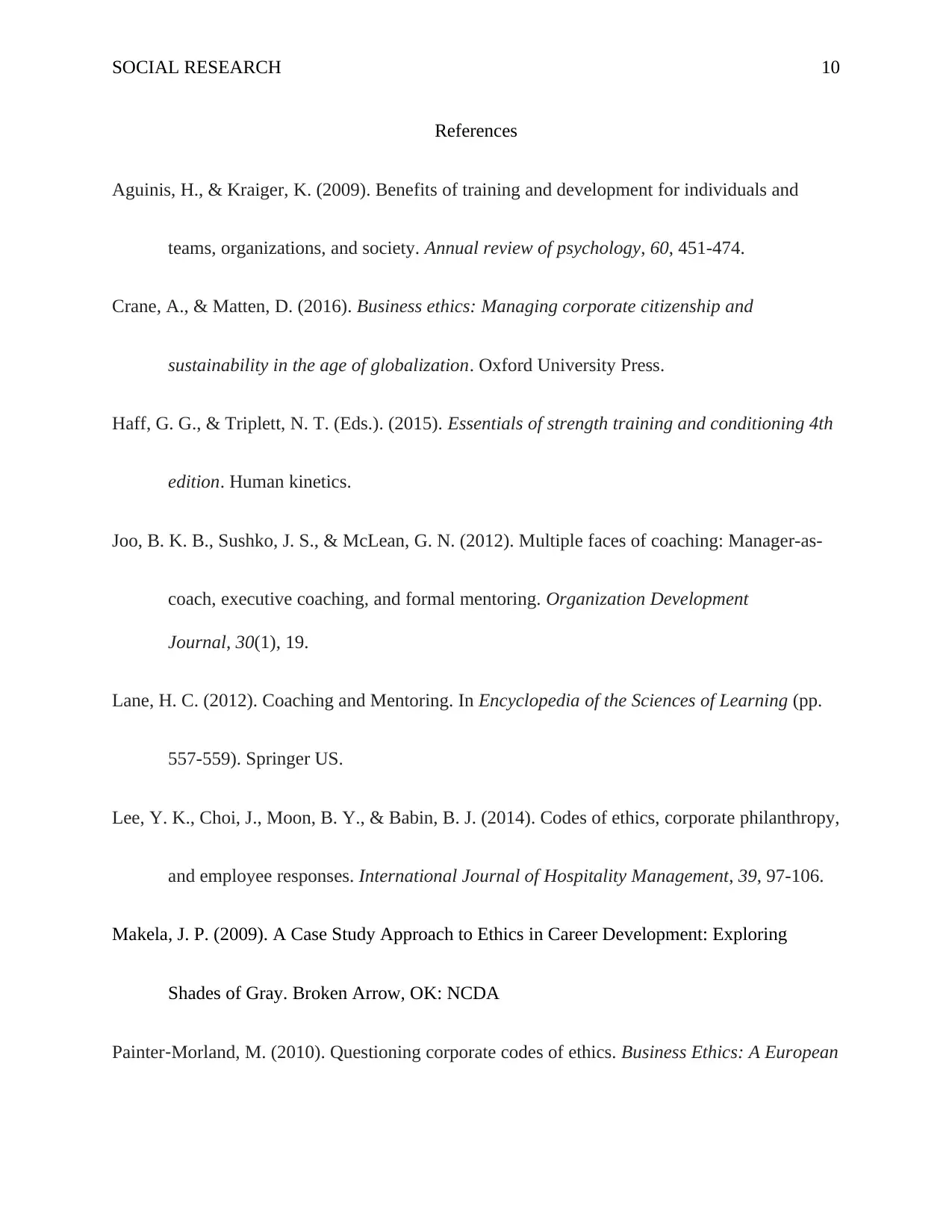
SOCIAL RESEARCH 10
References
Aguinis, H., & Kraiger, K. (2009). Benefits of training and development for individuals and
teams, organizations, and society. Annual review of psychology, 60, 451-474.
Crane, A., & Matten, D. (2016). Business ethics: Managing corporate citizenship and
sustainability in the age of globalization. Oxford University Press.
Haff, G. G., & Triplett, N. T. (Eds.). (2015). Essentials of strength training and conditioning 4th
edition. Human kinetics.
Joo, B. K. B., Sushko, J. S., & McLean, G. N. (2012). Multiple faces of coaching: Manager-as-
coach, executive coaching, and formal mentoring. Organization Development
Journal, 30(1), 19.
Lane, H. C. (2012). Coaching and Mentoring. In Encyclopedia of the Sciences of Learning (pp.
557-559). Springer US.
Lee, Y. K., Choi, J., Moon, B. Y., & Babin, B. J. (2014). Codes of ethics, corporate philanthropy,
and employee responses. International Journal of Hospitality Management, 39, 97-106.
Makela, J. P. (2009). A Case Study Approach to Ethics in Career Development: Exploring
Shades of Gray. Broken Arrow, OK: NCDA
Painter‐Morland, M. (2010). Questioning corporate codes of ethics. Business Ethics: A European
References
Aguinis, H., & Kraiger, K. (2009). Benefits of training and development for individuals and
teams, organizations, and society. Annual review of psychology, 60, 451-474.
Crane, A., & Matten, D. (2016). Business ethics: Managing corporate citizenship and
sustainability in the age of globalization. Oxford University Press.
Haff, G. G., & Triplett, N. T. (Eds.). (2015). Essentials of strength training and conditioning 4th
edition. Human kinetics.
Joo, B. K. B., Sushko, J. S., & McLean, G. N. (2012). Multiple faces of coaching: Manager-as-
coach, executive coaching, and formal mentoring. Organization Development
Journal, 30(1), 19.
Lane, H. C. (2012). Coaching and Mentoring. In Encyclopedia of the Sciences of Learning (pp.
557-559). Springer US.
Lee, Y. K., Choi, J., Moon, B. Y., & Babin, B. J. (2014). Codes of ethics, corporate philanthropy,
and employee responses. International Journal of Hospitality Management, 39, 97-106.
Makela, J. P. (2009). A Case Study Approach to Ethics in Career Development: Exploring
Shades of Gray. Broken Arrow, OK: NCDA
Painter‐Morland, M. (2010). Questioning corporate codes of ethics. Business Ethics: A European
Paraphrase This Document
Need a fresh take? Get an instant paraphrase of this document with our AI Paraphraser

SOCIAL RESEARCH 11
Review, 19(3), 265-279.
Phillips, C. (2010). Using interpreters: A guide for GPs. Australian family physician, 39(4), 188.
Viney, R., & Harris, D. (2013). Coaching and Mentoring. Leadership in Psychiatry, 126-136.
Review, 19(3), 265-279.
Phillips, C. (2010). Using interpreters: A guide for GPs. Australian family physician, 39(4), 188.
Viney, R., & Harris, D. (2013). Coaching and Mentoring. Leadership in Psychiatry, 126-136.
1 out of 11
Related Documents
Your All-in-One AI-Powered Toolkit for Academic Success.
+13062052269
info@desklib.com
Available 24*7 on WhatsApp / Email
![[object Object]](/_next/static/media/star-bottom.7253800d.svg)
Unlock your academic potential
© 2024 | Zucol Services PVT LTD | All rights reserved.





